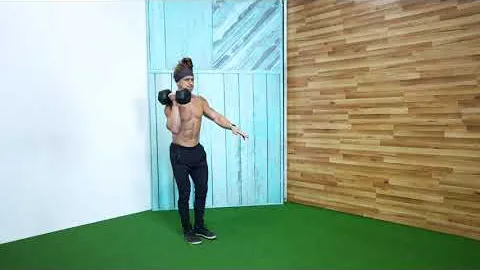
If you're looking to take your lower body strength and stability to the next level, look no further than the Single Arm DB Rack Pistol Squat. This challenging exercise not only targets your quads, glutes, and hamstrings, but also works your core, balance, and flexibility. In this article, we'll explore the benefits of the Single Arm DB Rack Pistol Squat and provide step-by-step instructions on how to perform it correctly.
Increased Lower Body Strength: The Single Arm DB Rack Pistol Squat places a significant load on your quads, glutes, and hamstrings, helping to develop lower body strength and muscular endurance.
Enhanced Core Stability: To maintain balance during this exercise, you need to engage your core muscles, strengthening them in the process.
Improved Balance and Coordination: The Single Arm DB Rack Pistol Squat is a unilateral exercise, meaning that you work each leg individually. This helps to improve balance and coordination, as well as identify and correct any muscular imbalances between your left and right side.
Heightened Flexibility: Performing the Single Arm DB Rack Pistol Squat requires considerable hip and ankle mobility. Regular practice of this exercise can improve your overall flexibility, making it easier to perform other exercises and movements.
Before attempting the Single Arm DB Rack Pistol Squat, it is essential to warm up your lower body and activate the muscles you'll be using. Try some dynamic stretches, such as lunges or leg swings, followed by activation exercises like glute bridges and clamshells.
Once warmed up, follow these step-by-step instructions:
Set up the Rack: Position a dumbbell rack so that it is in line with your shoulder and hip on one side of your body. Choose a dumbbell weight that challenges you but allows you to maintain proper form throughout the exercise.
Approach the Rack: Stand in front of the rack with your feet hip-width apart. Reach out with one hand and securely grip the dumbbell's handle, making sure it rests comfortably on your shoulder.
Assume the Starting Position: With the dumbbell resting on your shoulder, lift the opposite leg up and extend it straight in front of you. Keep your chest up, core engaged, and your opposite arm out in front for balance.
Initiate the Squat: Slowly lower your body down by bending at the knee and hip of the standing leg. Maintain control throughout the movement and strive to maintain a straight back.
Achieve Full Depth: Continue lowering yourself until your thigh is parallel to the ground or as close as you can comfortably go while maintaining proper form. At the bottom position, your extended leg should ideally be fully extended with your heel lifted slightly off the ground.
Drive Back Up: Push through the heel of the standing leg and engage your quads and glutes to rise back up to the starting position. Keep your core tight throughout the movement to maintain stability.
Repeat on the Opposite Side: Perform the desired number of repetitions on one side before switching to the other. Aim for a balanced number of reps on each leg to prevent muscle imbalances.
To ensure you get the most out of the Single Arm DB Rack Pistol Squat and avoid injury, keep the following tips in mind:
Master the Bodyweight Pistol Squat: Before attempting the Single Arm DB Rack Pistol Squat, it is crucial to master the bodyweight version of the exercise. This will help you develop the necessary strength, balance, and mobility.
Maintain Proper Alignment: Throughout the exercise, keep your knee aligned with your toes, and avoid letting it collapse inward. This will help prevent knee pain and maintain proper form.
Engage Your Core: Throughout the movement, engage your core by pulling your belly button in towards your spine. This will help maintain stability and prevent lower back pain.
Start with Light Weights: When first attempting the Single Arm DB Rack Pistol Squat, start with lighter weights to focus on form and balance. Gradually increase the weight as your strength and stability improve.
Take It Slow: The Single Arm DB Rack Pistol Squat is a challenging exercise that requires control and balance. Take your time and focus on maintaining proper form throughout the movement.
The Single Arm DB Rack Pistol Squat is a highly effective exercise for developing lower body strength, stability, and flexibility. By incorporating this exercise into your workout routine, you can build a strong, well-balanced lower body and improve your overall athletic performance. Remember to start with proper warm-up and progress gradually, mastering the bodyweight version before adding weight. With consistency and dedication, you'll be well on your way to mastering this ultimate lower body exercise.
If you're looking for a gym, fitness club or yoga studio, you've come to the right place.
You can find information about gyms in your area. Browse catalog of gyms and find gyms with classes which are you looking for.
On gym page you can find simple information like address, phone or website. You can find list of available classes. You can check availability of personal training or small group classes. On place page you can also see information about open hours.
You can find gyms near you with amenities, courts, studios and equipments.
Use our map to find gym at your city or district.
In Gym Navigator you can find list of exercises with movies for many body parts.
You can browse exercises catalog and find exercises the best of you.
You can also find exercises grouped into workout plans, which you can use to improve you body. Each routine show you exercises one by one and give you possibility to count you progress and count down rest time.